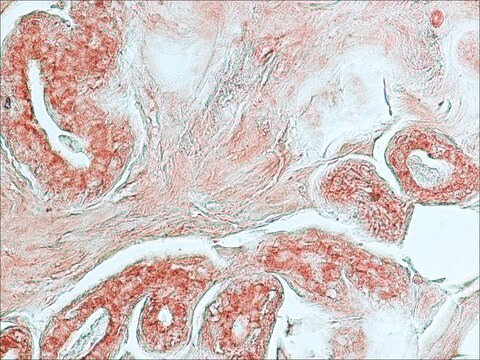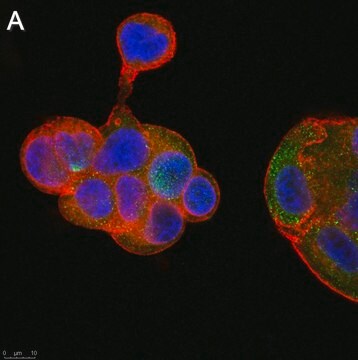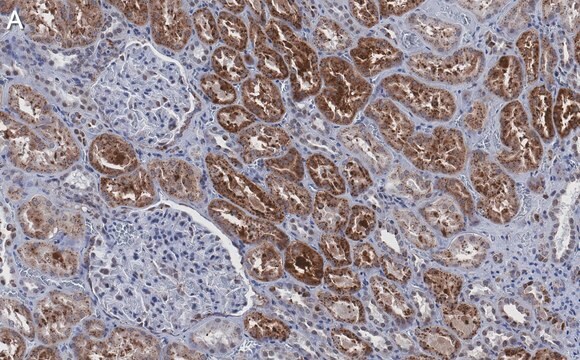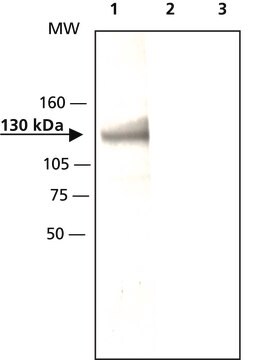一般說明
We are committed to bringing you greener alternative products, which adhere to one or more of The 12 Principles of Green Chemistry.This antibody is Preservative-free, produced without the harm or sacrifice of animals and exceptionally stable to allow for ambient shipping and storage if needed and thus aligns with "Waste Prevention", "Designing Safer Chemicals" and "Design for Energy Efficiency".
Click here for more information.
ZooMAb® antibodies represent an entirely new generation of recombinant monoclonal antibodies.Each ZooMAb® antibody is manufactured using our proprietary recombinant expression system, purified to homogeneity, and precisely dispensed to produce robust and highly reproducible lot-to-lot consistency. Only top-performing clones are released for use by researchers. Each antibody is validated for high specificity and affinity across multiple applications, including its most commonly used application. ZooMAb® antibodies are reliably available and ready to ship when you need them.
特異性
Clone 1D16 is a ZooMAb® Rabbit recombinant monoclonal antibody that specifically detects pro-cathepsin D. It targets an epitope within 25 amino acids from the N-terminal, propeptide region.
免疫原
KLH-conjugated linear peptide corresponding to 25 amino acids from the N-terminal, propeptide region of human Cathepsin D.
應用
Quality Control Testing
Evaluated by Western Blotting in MCF-7 cell lysate.
Western Blotting Analysis: A 1:1,000 dilution of this antibody detected pro-Cathepsin D in MCF-7 cell lysate.
Tested applications
Western Blotting Analysis: A 1:1,000 dilution from a representative lot detected pro-Cathepsin D in A549, NIH3T3, and L6 cell lysates.
Immunocytochemistry Analysis: A 1:100 dilution from a representative lot detected pro-Cathepsin D in MCF-7 cells.
Immunohistochemistry (Paraffin) Analysis: A 1:1,000 dilution from a representative lot detected pro-Cathepsin D in human liver tissue sections.
Affinity Binding Assay: A representative lot of this antibody bound pro-Cathespin D peptide with a KD of 2.4 x 10-8 in an affinity binding assay.
Note: Actual optimal working dilutions must be determined by end user as specimens, and experimental conditions may vary with the end user
Evaluated by Western Blotting in MCF-7 cell lysate.
Western Blotting Analysis: A 1:1,000 dilution of this antibody detected pro-Cathepsin D in MCF-7 cell lysate.
標靶描述
Cathepsin D (UniProt: P07339; also known as EC:3.4.23.5, Pro-CTSD) is encoded by the CTSD (also known as CPSD) gene (Gene ID: 1509) in human. Cathepsin D is a ubiquitously expressed, major lysosomal and secreted aspartic protease that is synthesized as a pro-cathepsin with a signal peptide (aa 1-20) and an activation peptide (aa 21-64) that are subsequently cleaved off. Following the removal of the signal peptide within the endoplasmic reticulum, the inactive pro-cathepsin D is glycosylated and transported to the Golgi compartment, where the mannose residues are phosphorylated for targeting to lysosomes via the mannose-6-phosphate pathway. An acidic environment is important for proteolytic processing and maturation of cathepsin D. Once in the endosomes, the phosphate groups and the activation peptide (pro-peptide) are removed to generate an active intermediate. In the lysosomal compartment, this single-chain intermediate is further processed into a double-chain mature form consisting of an N-terminal light chain (aa 65-162) and a C-terminal heavy chain (aa 169-412) that remain associated in a non-covalent manner. Cathepsin D plays an active role in intracellular protein breakdown. It is reported to be involved in the degradation of various substrates, including -synuclein, amyloid precursor protein (APP) and tau, all of which tend to aggregate and lead to neurodegenerative diseases if not efficiently degraded. Increased tissue expression of cathepsin D has been correlated with higher incidence of cancer and poor outcome in a number of cancers. Overexpression of cathepsin D in human breast cancers is associated with higher risk of relapse and metastasis. This ZooMAbZooMAb® recombinant monoclonal antibody, generated by our propriety technology, offers significantly enhanced specificity, affinity, reproducibility, and stability over conventional monoclonals. (Ref.: Bunk, J., et al. (2021). Front. Cell Dev. Biol. 9; :581805; Garcia, M., et al. (1996). Stem Cells. 14(6); 642-650; Kobayashi, T., et al. (1992). Int. J. Biochem. 24(9); 1487-1491).
外觀
Purified recombinant rabbit monoclonal antibody IgG, lyophilized in PBS, 5% Trehalose, normal appearance a coarse or translucent resin. The PBS/trehalose components in the ZooMAb formulation can have the appearance of a semi-solid (bead like gel) after lyophilization. This is a normal phenomenon. Please follow the recommended reconstitution procedure in the data sheet to dissolve the semi-solid, bead-like, gel-appearing material. The resulting antibody solution is completely stable and functional as proven by full functional testing. Contains no biocide or preservatives, such as azide, or any animal by-products. Larger pack sizes provided as multiples of 25 μL.
重構
300 μg/mL after reconstitution at 25 μL per vial. Please refer to guidance on suggested starting dilutions and/or titers per application and sample type.
儲存和穩定性
Recommend storage of lyophilized product at 2-8°C; Before reconstitution, micro-centrifuge vials briefly to spin down material to bottom of the vial; Reconstitute each vial by adding 25 μL of filtered lab grade water or PBS; Reconstituted antibodies can be stored at 2-8°C, or -20°C for long term storage. Avoid repeated freeze-thaws.
法律資訊
ZooMAb is a registered trademark of Merck KGaA, Darmstadt, Germany
免責聲明
Unless otherwise stated in our catalog or other company documentation accompanying the product(s), our products are intended for research use only and are not to be used for any other purpose, which includes but is not limited to, unauthorized commercial uses, in vitro diagnostic uses, ex vivo or in vivo therapeutic uses or any type of consumption or application to humans or animals.










